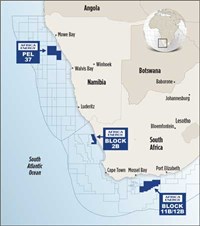South Africa, Namibia prospects set the stage for E&P revival
During the recent downturn in oil prices, South Africa was one of several regions around the globe that saw a dramatic drop in exploration. Many operators focused their attention on production and cash flow, insisting that exploration in these areas was just too risky. “Now, oil prices are higher and oil demand continues to climb. The industry has realized that it needs to start replacing reserves, and there is this rush to catch up on the exploration side,” said Africa Energy Corp. CEO Garrett Soden.
“There’s been some great recent success by Exxon, offshore Guyana, and others that have renewed interest in creating value through exploration. I think the majors see southern Africa as one of the last remaining under-explored regions, where there is potential for very large discoveries.”
Last year, several majors entered the region, hoping to tap into a sizeable resource base. In September, Statoil acquired participating interests in two frontier blocks offshore South Africa—12/3/252 Transkei-Algoa and 12/3/257 East Algoa. Concurrently, Rosgeo entered a multi-million-dollar agreement with PetroSA, South Africa’s national oil company, to develop Blocks 9 and 11a. Operators are moving into the region, largely due to its recent political changes. With a new president and a new mineral resources minister, expected regulatory reforms are creating a more attractive environment for foreign investment.
Likewise, Africa Energy Corp., a Lundin Group company, recognizes the potential that this region has to strike big. The company has plans to drill several exploration wells offshore South Africa and Namibia this year. In Block 11B/12B, where Africa Energy holds a 4.9% interest and Total operates, resource potential reportedly is very high in the Outeniqua basin. “This is a legendary block and has been well known since the ‘80s and ‘90s,” said Soden. “This is a Johan Sverdrup-type opportunity, like the Lundin Petroleum discovery offshore Norway, with over 2 Bbbl of prospective resource potential.”
Soden says the Brulpadda prospect, on Block 11B/12B, is expected to begin drilling in December. This will be summertime for South Africa, when seas are calmer and drilling operations can be carried out more easily. The well, which will be drilled in water depths of nearly 4,695 ft, has a high likelihood of success, considering its close proximity to the proven petroleum systems of Oribi, Oryx and Sable oil fields. “There’s only 2D seismic on the block, but the structures are very obvious,” Soden said. “There are direct hydrocarbon indicators—flat spots that you just don’t normally see, so everyone believes that there’s a very high chance of success here.”
Block 2B, off South Africa’s western coast, contains a proven oil basin, where high-quality oil flowed back in 1988. Africa Energy operates the block with a 90% participating interest. The block already contains nearly 50 MMbbl of contingent resources, with estimated prospective resources of more than 800 MMbbl. The company is conducting a farm-out to share costs, and plans to drill a well in 2019.
Like South Africa, Namibia holds significant resource potential, as well. The Cormorant exploration well is expected to spud on Sept. 1 on PEL 37, where Africa Energy holds a 10% interest and Tullow Oil operates. The well—which will be drilled in water depths of nearly 1,805 ft in the Walvis basin—could open up four prospects on the block with estimated prospective resource potential of about 1.5 Bbbl.
According to Soden, resources offshore South Africa will be easier to monetize than those of many other African nations, due to more advanced infrastructure. “If we discover gas, it would be very easy to commercialize, with the nearby gas-to-liquids plant operating below capacity,” Soden explained, referring to the Mossel Bay facility.
“But we’re fairly confident that this is oil,” Soden said. “In the oil scenario, it would be easy to deliver oil to the Cape Town refinery.” ![]()
- What's new in exploration (November 2023)
- Management issues- Dallas Fed: Activity sees modest growth; outlook improves, but cost increases continue (October 2023)
- What's new in exploration (March 2023)
- The last barrel (January 2023)
- What's new in exploration (January 2023)
- Nova Scotia’s re-starting of exploration is a solid move, says exploration expert (January 2023)
- Applying ultra-deep LWD resistivity technology successfully in a SAGD operation (May 2019)
- Adoption of wireless intelligent completions advances (May 2019)
- Majors double down as takeaway crunch eases (April 2019)
- What’s new in well logging and formation evaluation (April 2019)
- Qualification of a 20,000-psi subsea BOP: A collaborative approach (February 2019)
- ConocoPhillips’ Greg Leveille sees rapid trajectory of technical advancement continuing (February 2019)



